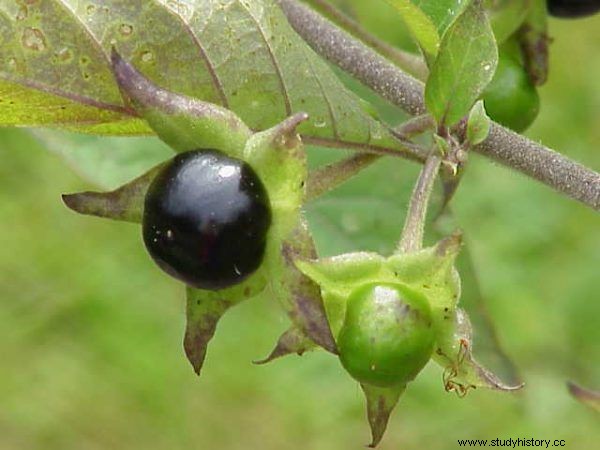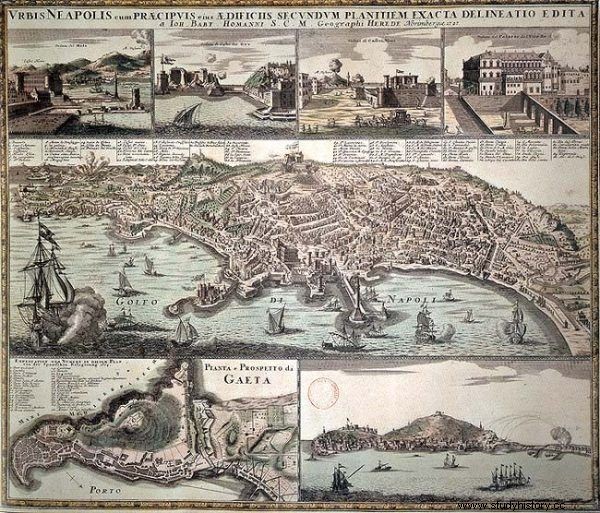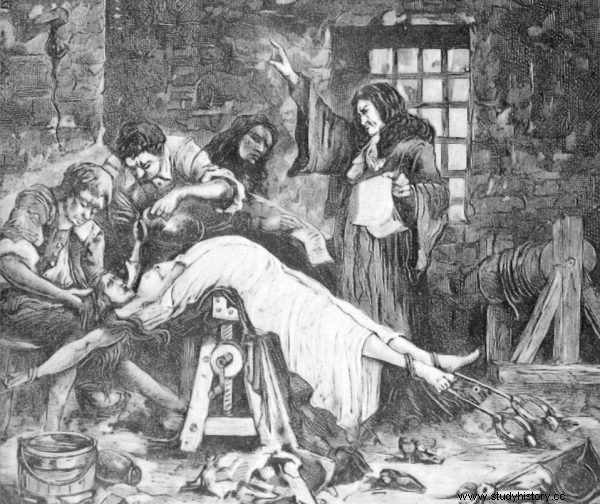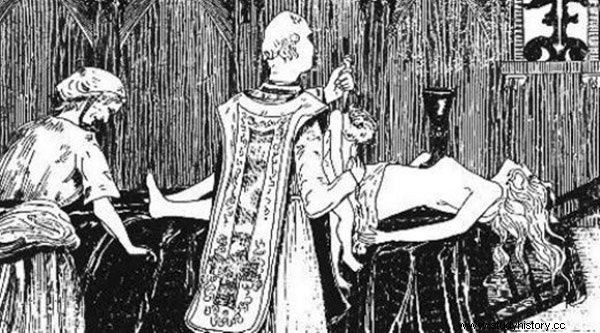Four hundred years ago, the chances of marrying a man you love weren't great. When the husband absolutely did not live up to expectations, decisive measures had to be taken. Sometimes the only solution was poison. Here are some proven tips for desperate wives. Maybe they will also be useful today?
The mistress of the house faced many challenges in trying to get rid of her husband. She had to overcome not only moral resistance. It was also necessary to carefully select the appropriate resources and collaborators. She risked a lot - in case of failure she could even be killed at the stake .
1. Look for poison in the immediate vicinity
The main obstacle to the crime was finding the right means. Women who knew herbs often used plants that could be found in a meadow or in the forest. Datura, aconite and nightshade were popular .
However, arsenic made the greatest career. The real king of poisons , known since antiquity, was quite easily available:it was sold as poison for mice or rats. Before 1815, there were no restrictions on trading in England in England. The price was also affordable, especially since a small amount of poison could lead to death. Hardly any seller asked customers what they would use the purchased product for…

The wolfberry looks inconspicuous, and it can kill in good hands… (photo:Kurt Stüber, license CC BY-SA 3.0). Arsenic poisoning caused severe abdominal pain, nausea and vomiting. Lower doses resulted in loss of hair, nails, skin ulceration, indigestion and loss of appetite but also a persistent cough. As you can see, these symptoms resembled more than one disease, and therefore the poisoned person may not even realize the danger he is in.
2. Consult specialists
Preparing poison is not a job for the stately housewife. The best solution is to find a professional, a true expert in poisoning art to recommend the best specifics.

17th-century Naples was the scene of a great poisoning scandal. Panorama of Naples by Johann Baptist Homann from 1727 (source:public domain).
The choice of poison was also guided by fashion. Aqua Tofana was extremely popular in the 17th century. The specificity was based on arsenic. He was supposed to kill within three days . It was first used by the Sicilian Teofania di Adamo. However, she was not very lucky, as she was captured in 1633 and died a cruel death:hanged and then dismembered.
Aqua Tofana has not been forgotten. In the 1740s, three women from Naples were accused of poisoning with the drug. Due to incomplete files, however, it is not known what their fate was.
Real business using Aqua Tofana started in the 1950s in Rome. A group of women, including Giulia Tofano from Palermo (perhaps the daughter of Teofania di Adamo), Girolama Spara, and four Roman women, were involved in selling arsenic-based concoctions

Preparing poisons for many of the ladies in Tofana and Spara's circle ended up in a noose. John William Waterhouse's painting of Circe, often mistakenly thought of as Giulia Tofana's portrait (source:public domain).
.
Tofana was not reached by the hand of justice. She died unchallenged by anyone in 1651. After her death, Spara took over the group. For her, preparing poisons was associated with some kind of mission . To poor women who were persecuted by their husbands, she sold her drugs well below the cost.
3. Be careful that your advisers don't throw you in
When Francesco Cesi, Duke of Ceri, died, his unexpected death drew suspicion on the mighty's young wife, Maria Aldobrandini. Rome was then engulfed in a real witch-hunt fever . Every widow, especially one who was still in her prime, was looked upon with suspicion.
Finally, in 1659, five women from Spara's group dealing with the distribution of poisons were hanged . Maria Aldobrandini herself barely escaped with her life. Her name was removed from the trial file and she died peacefully in 1705.
Also in the Commonwealth, there were women who "solved" marital problems in this way. In 1593, during an investigation into the death of Stanisław Utkowski, a certain Regina was interrogated. She stated that the deceased's wife, Magdalena, accused of this crime, asked her for help in killing her spouse. Regina, on behalf of Mrs. Utkowska, asked women in Rus about witchcraft or poison .
Also in 1624, in Lviv, Agnieszka Klimuntowiczowa reached for a poisonous substance in order to become a widow. She paid for her act with her head .
4. Don't mess with ambitious law enforcement
The greatest danger was posed by extremely stubborn policemen. One of them was Nicolas la Reyna, who headed the Paris police under Louis XIV. He pursued alchemists, witches and all those who tried to use arcane powers. It was he who won the laurels for working out the biggest poisoning scandal in France .
The whole story began innocently, with one woman who decided to eliminate those members of her family who seemed redundant to her . Marie Madeleine Gobelin, Marquis de Brinvilliers, because we are talking about her, did not find happiness in marriage. She sought consolation in Gaudin de Sante-Croix's arms.

It was absolutely not a good idea to mess with La Reyna. Painting by Pierre Mignard from around 1670 (source:public domain).
Marie's husband did not oppose this relationship until the spouse began to consider separating her property from her husband's. Then the scoop also changed for the woman's family. They led to Gaudin's imprisonment in 1663. While in custody, he met the Italian poisoner Poisoni.
After leaving prison, he and his beloved began experimenting with all sorts of potions. Within a few years, two brothers and Marie's father died . However, their deaths did not raise suspicions.
It was only the mysterious death of Gaudin that led to the initiation of an investigation, which led to the disclosure of compromising letters. Terrified, the Brinviliers fled to England and then the Netherlands. However, she failed to escape justice. She was arrested in 1675 and then deported to France.

As shown in the illustration, Marie was subjected to elaborate torture prior to beheading (source:public domain).
Initially, she did not admit to poisoning anyone. She tried to blame all the blame on her deceased lover. Only under torture did she testify that she poisoned her father, two brothers, and tried to poison her sister-in-law and husband. She claimed that she committed the murders to ensure the education and proper social position of her children.
On July 16, 1676, she was punished for her actions. It was La Reyna who contributed to her conviction. She was beheaded and her body was burned . This did not mean the end of the story, however, as the king ordered the head of the Paris police to conduct a thorough investigation.
5. In case of failure, don't count on anyone (except the king)
One of the most famous victims of the Parisian poisoner campaign was Catherine Deshayes, Madame Montvosin, known as La Voisin. It offered services in the field of witchcraft, poison sales, and also abortion.
She was arrested on March 12, 1679, returning home after mass. During the investigation, she stated that her clients were the social cream of the then France. She admitted that many influential people sought in her a way to kill someone. Prominent customers, however, did not save the lives of the helpers. She was burned at the stake in 1680.
Her arrest led to further investigations. However, not all suspects have been tried. The name of the king's long-time favorite has been removed from the trial files , Montespan awnings. Her influence at the court was so great that she was called the second wife of the king or the true queen of France.

This is how, at the end of the 19th century, the black mass performed by La Voisine and Father Étienne Guiborg on the naked body of Madame de Montespan was imagined. Illustration by Henry de Malvost from the book "Satanism and Magic" (source:public domain).
No wonder, after all, Mrs. Montespan bore the king seven children. In order to maintain her influence, she did not hesitate to resort to any methods. At La Voisin, she was to not only order beauty products, but even participate in a black mass .
As you can see, despite the lack of advanced investigative techniques, many poisoners had to say goodbye to their lives. Today, however, it is impossible to say how many widows managed to change their marital status on their own. At a time when an autopsy was something special, and toxicology did not exist, many crimes could have escaped the perpetrators ...
***
The crimes, lies and sins committed by the Polish Queen Maria, better known as Marysieńka Sobieska, were sure to get away with it. An extraordinary novel by Robert Forys, "Hetman's Gambit" is the story of women who want power above all else. They are ready to pay for it with gold, blood, poison, and even - with their own body.
